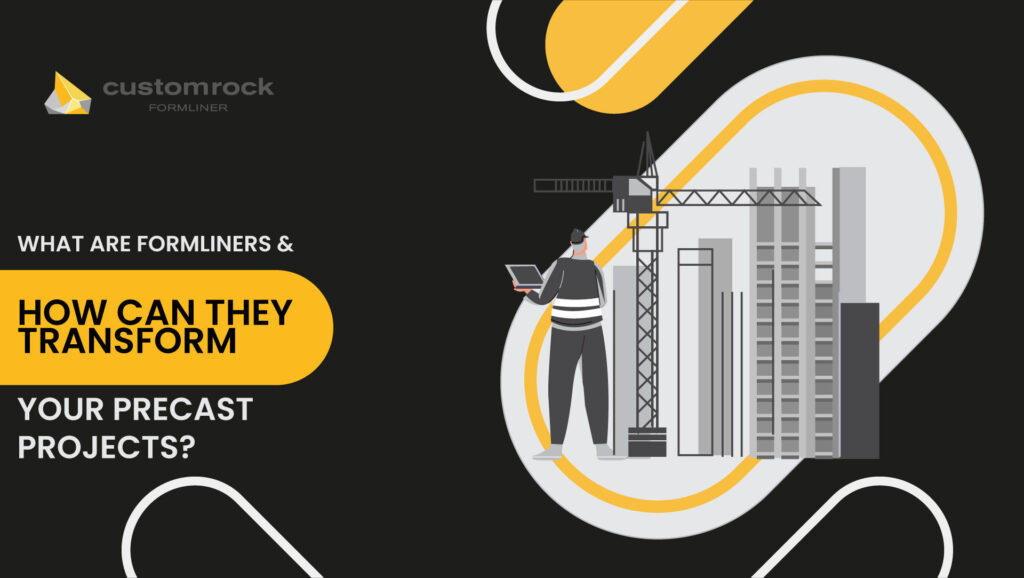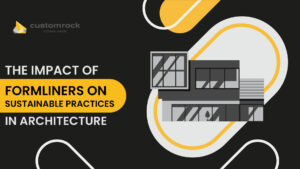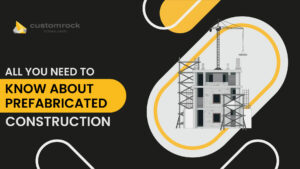In the world of construction, precast concrete is valued for its strength, versatility, and cost-effectiveness. But what if you could make it beautiful too? That’s where formliners come in. At Custom Rock, we specialize in architectural concrete formliners that turn plain concrete into stunning works of art.
Whether you’re aiming for the look of natural stone, wood, brick, or a unique custom design, our formliners can make it happen. In this blog, we’ll answer key questions about formliners, explore how they’re used with precast concrete, and explain why Custom Rock is your best partner for these projects.
What Exactly Are Formliners?
Formliners are molds or liners placed inside concrete forms to create textures, patterns, or designs on the surface of precast concrete. Think of them as stencils that give concrete a polished, artistic finish. They can mimic materials like stone or wood or create modern geometric patterns, all while keeping the concrete’s durability intact.
At Custom Rock, we offer over 200 standard formliner patterns, from classic textures to contemporary designs. If you have a specific vision, our team can craft custom formliners to match your project’s needs. This flexibility makes formliners a game-changer for architects, builders, and designers looking to elevate their work.
Formliners don’t just enhance aesthetics—they add value by making structures more visually appealing. Whether it’s a commercial building, a public plaza, or a residential project, formliners help your concrete stand out.
How Are Formliners Used in Precast Concrete?
Using formliners in precast concrete is a straightforward but precise process that combines creativity and technical skill. Here’s how it works:
- Design Selection: Start by choosing a pattern or creating a custom design. Custom Rock offers a vast library of standard patterns, or you can work with our design team for something unique.
- Mold Setup: A mold is built to match the size and shape of the precast concrete piece. This mold will hold the formliner during the pouring process.
- Formliner Placement: The formliner is carefully placed inside the mold, ensuring it’s secure to transfer the pattern accurately.
- Concrete Pouring: High-quality concrete is poured into the mold, filling the spaces around the formliner. Proper mixing and pouring techniques prevent air bubbles and ensure a smooth finish.
- Curing: The concrete cures in a controlled environment or on-site, depending on the project. Curing times vary based on the concrete type and conditions.
- Mold Removal: Once cured, the mold is removed, revealing the textured surface created by the formliner. Final touches, like cleaning or sealing, may be applied.
This process allows for intricate designs that would be challenging to achieve with traditional concrete methods. From walls and columns to floors and facades, formliners make precast concrete versatile and visually striking.
What Types of Formliners Are Available?
At Custom Rock, we offer several types of formliners to fit different project needs and budgets. Each type has unique benefits, depending on the design complexity, durability requirements, and cost considerations. Here’s a breakdown:
- Plastic Formliners: Affordable and versatile, these are great for both single-use and limited multi-use projects. They’re ideal for simpler textures and are easy to install, making them a popular choice for budget-conscious projects.
- Urethane Formliners: These are more durable and can handle intricate, detailed designs. They’re reusable multiple times, making them cost-effective for larger or repetitive projects.
- Elastomeric Formliners: Offering the highest flexibility and detail reproduction, these are perfect for complex patterns and can withstand extensive reuse without losing quality.
- Custom Formliners: For one-of-a-kind projects, Custom Rock creates bespoke formliners. Whether it’s a logo, architectural detail, or unique texture, we can bring your vision to life.
The table below compares these formliner types to help you choose the right one:
| Feature | Plastic Formliners | Urethane Formliners | Elastomeric Formliners |
| Durability | Moderate | High | Very High |
| Design Complexity | Low to Moderate | High | Very High |
| Cost | Low | Moderate to High | High |
| Reusability | Limited | High | Very High |
Our team at Custom Rock can guide you in selecting the best formliner based on your project’s goals, ensuring you get the perfect balance of aesthetics and functionality.
Why Choose Custom Rock for Your Formliner Needs?
When it comes to formliners, Custom Rock stands out as a trusted partner. Here’s why we’re the preferred choice for precast concrete projects:
- Vast Selection: With over 200 standard patterns and custom design options, we have solutions for every aesthetic need.
- Top-Quality Materials: Our formliners are made from premium materials, ensuring durability and consistent performance.
- Expert Guidance: Our experienced team provides insights and recommendations to make your project a success.
- Customer-First Approach: We prioritize your needs, offering personalized support from design to completion.
- Innovation: We stay ahead of industry trends, delivering the latest formliner technologies and designs.
By partnering with Custom Rock, you’re choosing a company dedicated to quality, creativity, and your project’s success. Check out our project gallery to see how our formliners have transformed real-world projects.
Top 5 FAQs About Formliners
1. What’s the difference between plastic and urethane formliners?
Plastic formliners are cheaper and suited for simpler designs with limited reuse, while urethane formliners are more durable and ideal for intricate patterns with multiple uses.
2. Can formliners be used for both precast and cast-in-place concrete?
Yes, formliners work for both, but the material choice may depend on the project’s specific needs. Custom Rock can advise on the best option.
3. How many times can a formliner be reused?
It depends on the material and care. Plastic formliners may last a few uses, while urethane and elastomeric formliners can be reused many times with proper maintenance.
4. Do formliners affect concrete’s structural integrity?
No, formliners only alter the surface texture and do not impact the concrete’s strength or durability.
5. Can I create a custom design with formliners?
Yes! Custom Rock specializes in custom formliners, allowing you to create unique designs like logos or specific textures.
Conclusion
Formliners are a powerful way to enhance the beauty of precast concrete, turning functional structures into architectural masterpieces. At Custom Rock, we offer a wide range of high-quality formliners, expert support, and custom solutions to bring your vision to life. Whether you’re working on a small project or a large development, our formliners can help you achieve stunning results.
Ready to elevate your next precast concrete project? Contact us today to discuss how Custom Rock can make it happen. Let’s create something extraordinary together!








